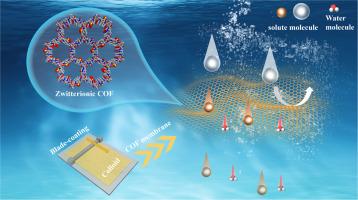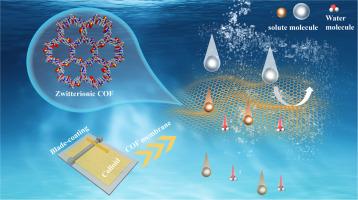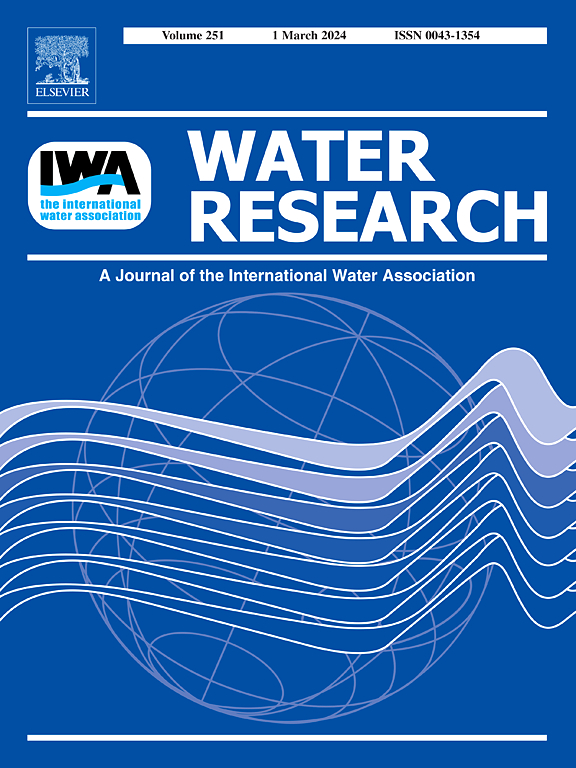Ultrathin zwitterionic COF membranes from colloidal 2D-COF towards precise molecular sieving
IF 12.4
1区 环境科学与生态学
Q1 ENGINEERING, ENVIRONMENTAL
引用次数: 0
Abstract
Membrane technology is an important component of resource recovery. Covalent organic frameworks (COFs) with inherent long-range ordered structure and permanent porosity are ideal materials for fabricating advanced membrane. Zwitterionic COFs have unique features beyond single ionic COFs containing anions or cations. Here, a zwitterionic colloidal 2D-COF (TpPa-Py) is synthesized via a single-phase method. ultrathin zwitterionic COF membranes are fabricated via a facile blade-coating method. Experimental and molecular dynamics simulation results showed that due to the unique amphiphilic nature of the TpPa-Py, the TpPa1-Py1 membrane exhibits high level permeance and rejection of both positively and negatively charged dyes. Moreover, the TpPa1-Py1 membrane exhibits excellent dye/dye and dye/salt separation performance. The selectivity factors were 89 for the separation of acid blue and rhodamine B, and 47.8 for the separation of methyl blue and NaCl. This work provides a promising solution for the development of high-performance membranes tailored for resource recovery of dye wastewater, addressing a critical need in water treatment.


从胶体2D-COF到精确分子筛选的超薄两性离子COF膜
膜技术是资源回收的重要组成部分。共价有机骨架(COFs)具有固有的长程有序结构和永久多孔性,是制备高级膜的理想材料。两性离子COFs比含有阴离子或阳离子的单离子COFs具有独特的特性。本文通过单相法合成了两性离子胶体2D-COF (TpPa-Py)。采用叶片涂布法制备了超薄两性离子COF膜。实验和分子动力学模拟结果表明,由于TpPa1-Py1独特的两亲性,TpPa1-Py1膜对带正电和负电的染料都表现出高水平的渗透和排斥。此外,TpPa1-Py1膜具有优异的染料/染料和染料/盐分离性能。对酸蓝和罗丹明B的选择性系数为89,对甲基蓝和NaCl的选择性系数为47.8。该研究为染料废水资源回收的高性能膜的开发提供了一个有希望的解决方案,解决了水处理的关键需求。
本文章由计算机程序翻译,如有差异,请以英文原文为准。
求助全文
约1分钟内获得全文
求助全文
来源期刊

Water Research
环境科学-工程:环境
CiteScore
20.80
自引率
9.40%
发文量
1307
审稿时长
38 days
期刊介绍:
Water Research, along with its open access companion journal Water Research X, serves as a platform for publishing original research papers covering various aspects of the science and technology related to the anthropogenic water cycle, water quality, and its management worldwide. The audience targeted by the journal comprises biologists, chemical engineers, chemists, civil engineers, environmental engineers, limnologists, and microbiologists. The scope of the journal include:
•Treatment processes for water and wastewaters (municipal, agricultural, industrial, and on-site treatment), including resource recovery and residuals management;
•Urban hydrology including sewer systems, stormwater management, and green infrastructure;
•Drinking water treatment and distribution;
•Potable and non-potable water reuse;
•Sanitation, public health, and risk assessment;
•Anaerobic digestion, solid and hazardous waste management, including source characterization and the effects and control of leachates and gaseous emissions;
•Contaminants (chemical, microbial, anthropogenic particles such as nanoparticles or microplastics) and related water quality sensing, monitoring, fate, and assessment;
•Anthropogenic impacts on inland, tidal, coastal and urban waters, focusing on surface and ground waters, and point and non-point sources of pollution;
•Environmental restoration, linked to surface water, groundwater and groundwater remediation;
•Analysis of the interfaces between sediments and water, and between water and atmosphere, focusing specifically on anthropogenic impacts;
•Mathematical modelling, systems analysis, machine learning, and beneficial use of big data related to the anthropogenic water cycle;
•Socio-economic, policy, and regulations studies.
 求助内容:
求助内容: 应助结果提醒方式:
应助结果提醒方式:


